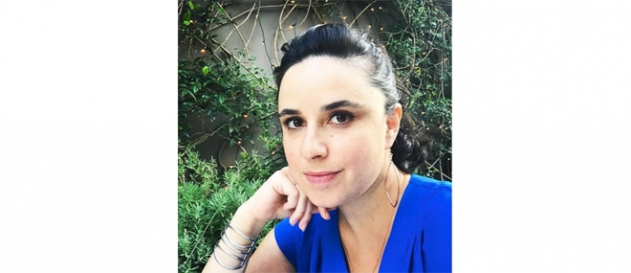
The non-profit group Women in Film has partnered with the Black List—an organization that annually surveys the best unproduced screenplays—to select rising female filmmakers for a residency to develop their scripts. Sloan-supported filmmaker Anya Meksin has been selected to participate in 2019 with her screenplay TAMINEX.
In addition to working on TAMINEX, Meksin is currently writing on a new Netflix series from creator Adam Glass, about a female Russian spy with body-morphing powers. In 2009, Meksin received a Sloan Production Award through Columbia University for her short film TEMMA, about a dying woman who creates a computational model of her mind that her family must cope with after she’s gone. TEMMA is available to watch through our streaming library.
We spoke with Meksin from her home in Los Angeles.
Science & Film: What is the story of TAMINEX?
Anya Meksin: TAMINEX takes place over the course of one night during an urban pandemic, as people in the city turn against immigrants and refugees because they blame them for bringing this deadly virus into their community. The story follows one Iranian woman, herself an immigrant, who ends up having to go outside official channels to get the only drug that can save her boyfriend’s life and her own—Taminex. It’s a visceral, non-stop survival experience that explores xenophobia through the lens of contagious disease.
S&F: It reminds me of the early days of the AIDS epidemic when people were fighting for access to drugs and advocating for drug development. What drew you to writing about something like this?
AM: My own experience of being a refugee from the Soviet Union and having to flee a society that blamed people like me for all its problems, only to find myself in a new place (the American Midwest) that also alienated and ostracized the outsider—that’s what drew me to stories that explore the other in society. The more you read about the rhetoric of xenophobic governments and individuals through history, the more you see xenophobia described in terms of disease. This fear of contamination by the other—that foreigners bring unclean elements into society. A lot of anti-immigrant campaigns utilize that language. I wanted to explore the subjective experience of being the other in a society that is looking for a scapegoat. How does it feel when, just by the body that you’re born in, you’re somehow marked as contaminated?
And while xenophobia is couched in the language of disease, actual pandemics are also couched in the language of xenophobia. There is a lot of racial and discriminatory language that goes into any outbreak. I looked into the Zika virus and how it sparked a xenophobic panic about immigration from South America. Even though very few people were infected, it was on the news constantly, and the coverage was about the dangers of South and Central America and the things that come from there. The Ebola outbreak that happened a few years ago was also characterized by this fearful language of African diseases creeping into white areas. And with what’s going on today at our borders, there is an overwhelming amount of dehumanizing rhetoric suggesting that refugees are bringing not just physical but also social diseases into our society—crime, violence, drugs, any social ill of choice becomes layered onto these people, who are the most defenseless and vulnerable among us.
The irony here is that while these refugee populations are being accused of bringing in disease, the reality is that numerous governments have historically benefited from the intentional spread of disease as a tool for colonial conquest—as far back as the North American extermination of native populations using smallpox. Every industrialized country in the world has a bio-weapons program, which develops virulent pathogens that can be used against enemy civilians. So disease is much more likely to be used as a weapon against vulnerable populations rather than the other way around.
S&F: How do you go about researching something as vast in subject matter as this?
AM: I’m the daughter of two scientists so I feel very comfortable reading scientific literature. I am fascinated by the intersection between science/technology and social issues. Where do technological changes cross over into affecting big societal change? For TAMINEX, I read a lot about the preparedness of our government for the next virulent flu outbreak. The more I looked into it, the more I realized that there’s only so much preparation that can be done even for a naturally mutating virus like the flu, let alone a genetically modified bioweapon. This film has had a really long development process so I’ve had years to educate myself on all the ways disease intersects with the geopolitical sphere.
TAMINEX is very different from most pandemic stories in film and TV, where you spend a lot of time with the scientists and government officials who are out there fixing the problem. Instead, TAMINEX is about the powerless, ordinary people who don’t have access to money and labs and research and helicopters—it’s the story of a frightened woman who doesn’t know who to trust, what to believe, where to go, or what to do to survive. Yet by banding together with other powerless people, she manages to find her own inner strength and power.
S&F: What stage is TAMINEX at now?
AM: TAMINEX has been green lit several times in the past, with me directing, but each time we moved towards production, things fell apart, which is a very common story. The problem is that it’s a little too expensive for what would be my first feature film, so right now I’m deciding whether I want to do another pass to make it significantly cheaper or if instead I should write another cheaper movie and have TAMINEX be my second feature. The script has many fans and supporters, for which I am grateful. My manager at Circle of Confusion, Lawrence Mattis, has done amazing work getting the project out to the industry, and the script has received support from IFP, Film Independent, and ScreenCraft, in addition to Women in Film and the Black List—so I remain ever hopeful that I can bring this story to the world someday soon.

Anya Meksin
Stay tuned to Science & Film for more as TAMINEX develops.
FILMMAKERS
PARTNERS
TOPICS